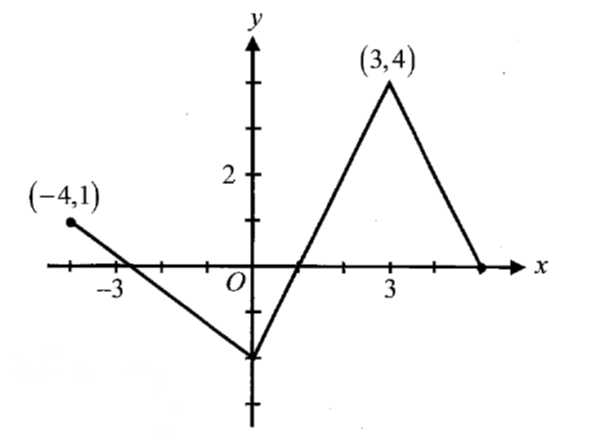AREA BOUNDED BY TWO PARABOLAS
Example 1 :
Find the area bounded by two parabolas,
4y2 = 9x and 3x2 = 16y
Solution :
First we need to draw the rough sketch of two parabolas to find the point of intersection.
4y2 = 9x ------ (1)
3x2 = 16y ------ (2)
4y2 = 9x
y2 = 9x/4
y = 3√x/2
y = (3/2) √x
3x2 = 16y
y = 3x2/16
By applying the value of y in the equation y2 = 9x/4.
(3x2/16)2 = 9x/4
9x4/256 = 9x/4
x4/x = (9 ⋅256)/(4 ⋅ 9)
x3 = 256/4
x3 = 64
x3 = 43
x = 4
By applying the value x = 4 in (1) or (2) we get the value of y
y = 3(4)2/16
y = 3
Therefore, the two parabolas are intersecting at the point (0, 0) and (4, 3).
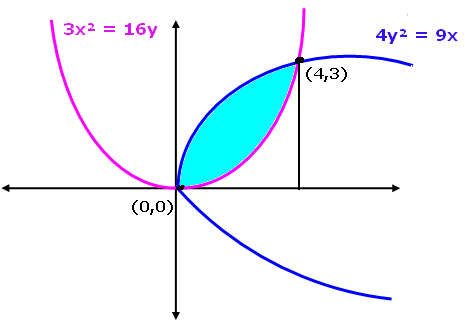
= (3/2)[x^(3/2)/(3/2)] - (3/16) [ x^3/3 ]
= { (3/2) [ 4^(3/2)/(3/2)]- (3/16) [4^3/3] } - 0
= { [ (3/2) ( 4 √4 ) x (3/2) ]- (3/16) [64/3] } - 0
= 4 (2)-4
= 8-4
= 4 square units
Therefore the required area = 4 square units.
Example 2 :
Find the area of the region bounded by the two parabolas
y = x2 and y2 = x.
Solution :
y = x2 -----(1)
y2 = x
y = √x -----(2)
x2 = √x
x4 = x
x4 - x = 0
x(x3-1) = 0
x = 0 and x = 1
y = 1
Point of intersection is at (0, 0) and (1, 1).
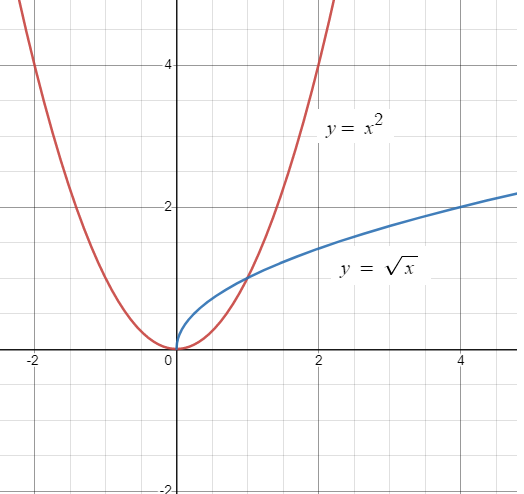
Required area = Integral 0 to 1 (√x - x2) dx
= [x3/2/(3/2) - x3/3] 0 to 1
= 0-(2/3) + 1/3
= 1/3 - 2/3
= 1/3 square units.
Example 3 :
The area between x = y2 and x = 4 is divided into two equal parts by the line x = a, find the value of a.
Solution :
x = y2
From the given equation, it is clear that the parabola is symmetric about x-axis it is open rightward parabola.
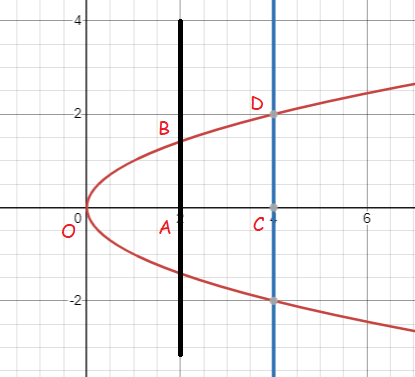
Area of OAB = Area of ACDB
Integral 0 to a √x dx = integral a to 4 √x dx
[x^(3/2)/(3/2)] limits are 0 and a = [x^(3/2)/(3/2)] limits are a to 4
x^(3/2) limits are 0 and a = x^(3/2) limits are a to 4
a^(3/2) - 0 = 4^(3/2) - a^(3/2)
2a^(3/2) = (2^2)^(3/2)
2a^(3/2) = 23
a^(3/2) = 8/2
a^3/2 = 4
a = 4^2/3
Example 4 :
The area of the region bounded by parabola y2 = x and the straight line 2y = x is
Solution :
y2 = x ------(1)
2y = x ------(2)
(1) = (2)
y2 = 2y
y2 - 2y = 0
y(y - 2) = 0
y = 0 and y = 2
Applying these values one by one, we get
x = 2(0) ==> 0
x = 2(2) ==> 4
So, the points of intersecting of these two curves are (0, 0) and (4, 2)
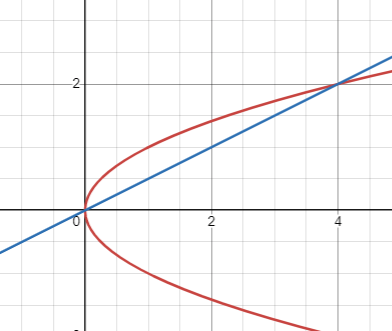
Using x values as limits, to figure out area in between these two curves, we have derive the function for y.
y = √x and y = x/2
= Integral 0 to 4 [√x - (x/2)] dx
= [x^(3/2) / (3/2) - (x2/2)] limits are 0 to 4
= [(2/3) x^(3/2) - (x2/4)] limits are 0 to 4
= (2/3) 4^(3/2) - (42/4)
= (2/3) 8 - 4
= (16/3) - 4
= (16 - 12) / 3
= 4/3 square units.
Example 5 :
The area of the region bounded by the curve y = x2 and the line y = 16
Solution :
The parabola is symmetric about y-axis and it opens upward.
To find the point of intersection of these two curves,
y = x2 ------(1)
y = 16 ------(2)
(1) = (2)
x2 = 16
x = 4 and -4
So, the point of intersections are (4, 16) and (-4, 16).
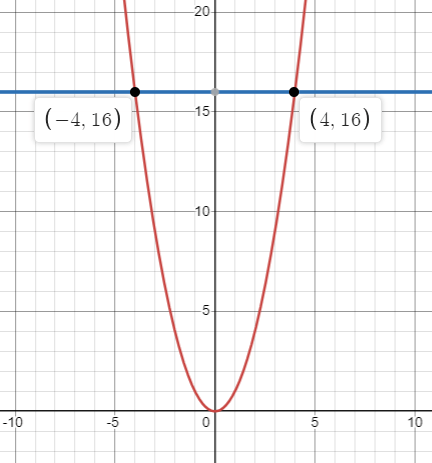
= integral -4 to 4 (16 - x2) dx
= (16x -x3/3) limits are -4 to 4
= 16(-4) - (-64/3) - 16(4) + 64/3
= -64 + (64/3) - 64 + 64/3
= -128 + (128/3)
= (-384 + 128)/3
= 256/3 square units.
Example 6 :
The area of the region bounded by the curve x2 = 4y and the line x = 4y - 2
Solution :
x2 = 4y ------(1)
x = 4y - 2 ------(2)
To find point of intersecting these two curves, (1) = (2)
√4y = 4y - 2
4y = (4y - 2)2
4y = 16y2 - 16y + 4
16y2 - 16y - 4y + 4 = 0
16y2 - 20y + 4 = 0
4y2 - 5y + 1 = 0
4y2 - 4y - 1y + 1 = 0
4y(y - 1) - 1(y - 1) = 0
(4y - 1)(y - 1) = 0
y = 1/4 and y = 1
x = 4y - 2
Applying y = 1/4, we get x = 4(1/4) - 2 ==> -1
Applying y = 1, we get x = 4(1) - 2 ==> 2
So, the point of intersections are (-1, 1/4) and (2, 1).
From (1) and (2)
x2/4 = y ------(1)
(x + 2)/4 = y ------(2)
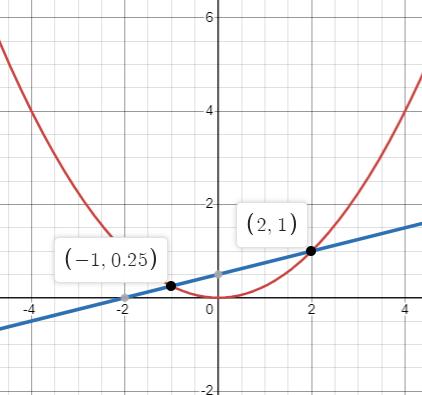
= integral -1 to 2 (16 - x2) dx
= (16x -x3/3) limits are -4 to 4
= 16(-4) - (-64/3) - 16(4) + 64/3
= -64 + (64/3) - 64 + 64/3
= -128 + (128/3)
= (-384 + 128)/3
So, 9/8 square units is the answer.
Kindly mail your feedback to v4formath@gmail.com
We always appreciate your feedback.
©All rights reserved. onlinemath4all.com
Recent Articles
-
Linear Inequality Word Problems with Solutions
Jan 11, 25 07:52 AM
Linear Inequality Word Problems with Solutions -
SAT Math Resources (Videos, Concepts, Worksheets and More)
Jan 10, 25 05:08 AM
SAT Math Resources (Videos, Concepts, Worksheets and More) -
Digital SAT Math Problems and Solutions (Part - 98)
Jan 10, 25 05:02 AM
Digital SAT Math Problems and Solutions (Part - 98)
